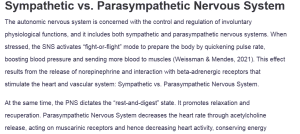Sympathetic vs. Parasympathetic Nervous System
The autonomic nervous system is concerned with the control and regulation of involuntary physiological functions, and it includes both sympathetic and parasympathetic nervous systems. When stressed, the SNS activates “fight-or-flight” mode to prepare the body by quickening pulse rate, boosting blood pressure and sending more blood to muscles (Weissman & Mendes, 2021). This effect results from the release of norepinephrine and interaction with beta-adrenergic receptors that stimulate the heart and vascular system: Sympathetic vs. Parasympathetic Nervous System.
At the same time, the PNS dictates the “rest-and-digest” state. It promotes relaxation and recuperation. Parasympathetic Nervous System decreases the heart rate through acetylcholine release, acting on muscarinic receptors and hence decreasing heart activity, conserving energy (Powers, 2023). Even though the SNS and PNS are complementary, their effects are antagonists, maintaining homeostasis in cardiovascular functions.
Heart Rate Impact
SNS and PNS act directly on the regulation of heart rate: the SNS increases heart rate and the strength of cardiac contractions to support the delivery of oxygen during physical or emotional stress, while the PNS decreases heart rate by inhibiting sinoatrial node activity, conserving energy and facilitating recovery at rest (Waxenbaum et al., 2023). A dynamic balance between these systems, termed sympathovagal balance, underlies heart rate variability, one of the essential signs of autonomic health.
Influence of Age and Disease
Aging depresses the parasympathetic tone and enhances sympathetic activity, leading to an increased resting heart rate and depressed HRV. Such disequilibrium between these two branches of the autonomic nervous system impedes the body`s adaptability to stressors and increases the possibility of arrhythmias. This imbalance is exaggerated in diseases like hypertension, diabetes, and heart failure (Giunta et al., 2023). Excessive sympathetic activation, common in heart failure, places undue stress on the myocardium, promoting disease progression and increasing mortality risks.
Beta-blockers in Case of Imbalance
Beta-blockers are highly important in managing autonomic imbalances, mainly in conditions of excessive sympathetic activity. By blocking beta-adrenergic receptors, it reduces heart rate, myocardial contractility, and oxygen demand, restoring autonomic balance (Farzam & Jan 2023). The drugs improve HRV, reduce arrhythmias, and are protective against myocardial damage, hence their indication in the treatment of heart failure, hypertension, and stress-induced cardiovascular diseases.
References
Farzam, K., & Jan, A. (2023, August 22). Beta blockers. National Library of Medicine; StatPearls Publishing. https://www.ncbi.nlm.nih.gov/books/NBK532906/
Giunta, S., Xia, S., Pelliccioni, G., & Olivieri, F. (2023). Autonomic nervous system imbalance during aging contributes to impairing endogenous anti-inflammation strategies. GeroScience. https://doi.org/10.1007/s11357-023-00947-7
Powers, S. (2023). Exercise physiology: Theory and application to fitness and performance (12th ed.). McGraw-Hill Higher Education. https://online.vitalsource.com/books/9781266201882
Waxenbaum, J. A., Varacallo, M., & Reddy, V. (2023, July 24). Anatomy, autonomic nervous system. Nih.gov; StatPearls Publishing. https://www.ncbi.nlm.nih.gov/books/NBK539845/
Weissman, D. G., & Mendes, W. B. (2021). Correlation of sympathetic and parasympathetic nervous system activity during rest and acute stress tasks. International Journal of Psychophysiology, 162, 60–68. https://doi.org/10.1016/j.ijpsycho.2021.01.015
ORDER A PLAGIARISM-FREE PAPER HERE
We’ll write everything from scratch
Question
04 Assignment:
- Define and discuss the difference between the sympathetic and parasympathetic nervous systems and how they impact heart rate. In what ways are they impacted by age and disease? How might beta-blockers be useful for someone with an imbalance between parasympathetic tone and sympathetic activity?
- Please use a source from either the reading or the lecture notes. The source for the reference is located below the reading section.
- Powers, S. (2023). Exercise Physiology: Theory and Application to Fitness and Performance (12th ed.). McGraw-Hill Higher Education (US). https://online.vitalsource.
com/books/9781266201882 -
- Chapters: 9-10
- 11th ed
-
Circulation and Respiration During Exercise

Sympathetic vs. Parasympathetic Nervous System
- Below are links to resources that will complement the material covered this week.
- American Lung Association – An organization dedicated to improving lung health and preventing lung disease through research, education, and advocacy. They focus on four initiatives: to defeat lung cancer, to improve the air we breathe; to reduce the burden of lung disease on individuals and their families and to eliminate tobacco use and tobacco-related diseases. Their blog includes articles that are specific to age, gender, ethnicity, and disease.
- http://www.lung.org/about-us/
blog/ Links to an external site.
- http://www.lung.org/about-us/
- American Heart Association – An organization dedicated to research, education, direct care services, and family support that will create healthier lives, free from cardiovascular diseases and stroke. Their research-based articles provide valuable information for professionals working with diverse clients.
- “Stress linked to behaviors that increase heart disease, stroke risk in African-Americans”
- “Stall in e-cigarette use among youth, reflected in CDC survey, worrisome, says American Heart Association”
- AHA Campaign to Reduce Salt Intake in Children
- https://act.sodiumbreakup.art.
org/RhetmsB21 Links to an external site.
- https://act.sodiumbreakup.art.
- Circulation and Respiration Resources – Khan Academy videos introducing the circulatory and respiratory systems.
- “Circulatory System and the Heart”
- “Meet the Lungs”
- “The Lungs and Pulmonary System”
- “Functions of the Nervous System”

